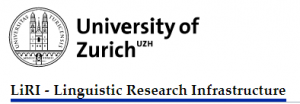CLARIN-CH technical center
The CLARIN-CH technical center is a distributed one and it consists of the Linguistic Research Infrastructure, which providers data and services and the SWISSUbase/LaRS national repository.
LiRI: national Linguistic Research Infrastructure

LiRI is a technology platform to serve the needs of quantitative research at UZH, Switzerland and beyond. As national research infrastructure, LiRI:
- Provides support services, facilities and equipment
- Enables collaborative research
- Deals with big data
- Engages with Open Science
- Enables Data Reproducibility
- Deals with the entire data life-cycle
The LiRI Language Technology team provides:
- IT services
- Application development, such as the LiRI Corpus Platform (LCP) to handle and query large corpora
- Data processing & NLP, such as automatic data processing with NLP tools, best practices, coaching, workshops, programming
- Swissdox@LiRI: a tool that allows retrieving large quantities of Swiss media data for research purposes
Lab space and equipment:
- LiRI lab for experimental research is equipped with a bundle of data acquisition units, mainly for use in phonetics, psycholinguistics and neurolinguistics
- On site and portable
Statistical consulting:
- Advice or feedback on study design, statistical methods
- Data analysis service

🆕 CLARIN-CH is now offering 10 vouchers for 4 statistical consulting hours from LiRI to researchers from CLARIN-CH member institutions. Update: two more left!
Read more | Apply here
For more information on LiRI's services, read here and have a look at the LiRI flyer.
SWISSUbase and the Language Repository of Switzerland LaRS
National data publication and archiving platform
LaRS@SWISSUbase is a FAIR compliant national platform for the publication and long-term archiving of linguistic research data on Swiss servers. It uses SWISSUbase as its repository system.
LaRS collaborates with LiRI to provide long-term data archiving services (such as, data processing and conversion, compilation of datasets for archiving, anonymization, metadata). The services are free for the CLARIN-CH community.
What you need to know about LaRS
How the data curation process works
For more information, read here and have a look at the SWISSUbase-LaRS flyer.

